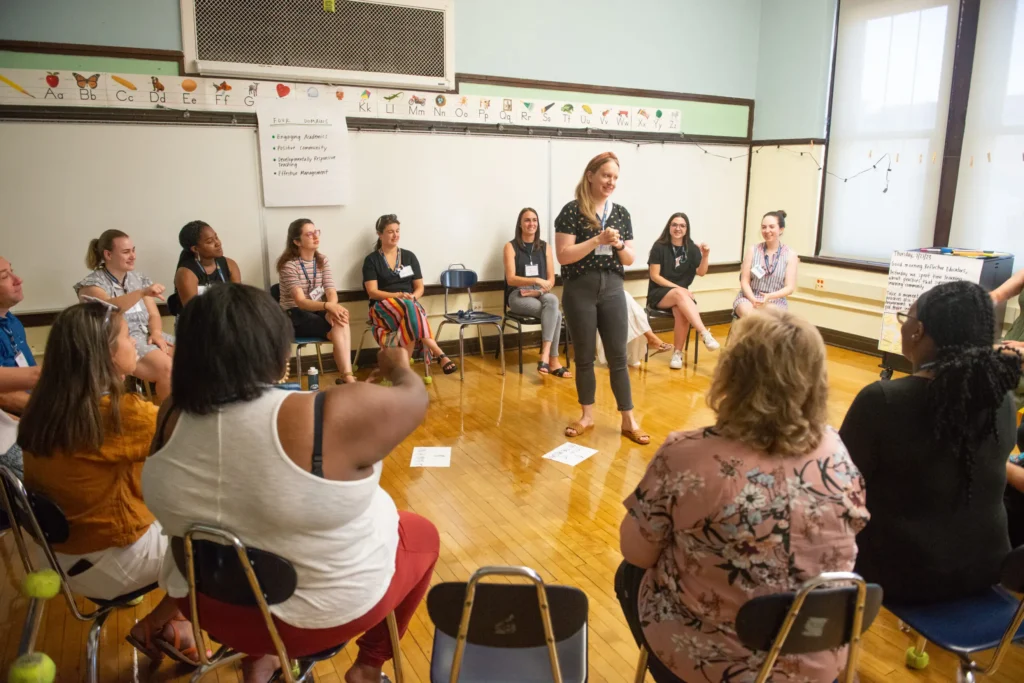
Imagine it’s back-to-school night, and families are beginning to arrive at a fourth grade classroom. As they walk in, the teacher warmly welcomes everyone and invites them to read a message chart posted at the front of the room. The message, just like the ones their children see each morning, invites them to make a nametag and greet someone they don’t know.
After a few minutes, a chime rings gently through the room. The teacher smiles and says, “It’s time to come to Morning Meeting,” and gestures toward a circle of chairs set up in the center of the classroom. As adults find their seats, the teacher explains: “We begin every school day with a twenty-minute Morning Meeting. Tonight, you’ll get to experience what that looks and feels like for your child.”
This simple, familiar routine helps set a welcoming tone for the evening, brings families into the experience of classroom life, and illustrates for them how Morning Meeting fosters both community and learning.
Teachers using the Responsive Classroom approach often structure family nights around a Morning Meeting format. This sets a positive tone for the evening, helps adults to feel welcomed and included, and gives families a first-hand experience of something their children do every day at school.
Whether it’s back-to-school night or a curriculum meeting, beginning these events in a circle using a Morning Meeting format helps develop positive community relationships. It also allows families to experience how social and academic learning are woven together during this part of the day.
When planning a Morning Meeting for parents and guardians, consider these two primary goals:
Here are a few ways to make sure your adult Morning Meeting is a fun, meaningful experience for everyone:
One of the most important things to keep in mind is that some adults may feel awkward and unsure of what to do when they first enter the classroom. They may feel they have already taken a big risk in just coming for the meeting. Be sure to greet people at the door when they arrive. Provide nametags so people can learn and become comfortable using each other’s names. And have a message chart and a meeting circle ready and waiting for them.
Once the adults are gathered in the circle, introduce the meeting. It is usually sufficient to say that the students begin every day with a Morning Meeting—a fifteen- to twenty-minute routine that builds community, sets a positive tone for the day, nurtures confidence and excitement about learning, and improves academic and social skills—and that tonight the adults will have a chance to experience a Morning Meeting firsthand.
Especially at the beginning of the year, avoid greetings and activities that are too silly or require physical contact. It’s also important to avoid activities that could embarrass anyone or put an individual on the spot. A greeting in which two adults are partnered and then introduce each other to the group often works well. For example: “This is Magda and her son is Isaac. He loves basketball.”
You may also ask students for suggestions of an appropriate activity for their families. Family members often enjoy learning a favorite activity of the students.
If you include sharing, keep it brief and focused. For example, you might ask people to share the names and grades of their children or one thing their child likes to do. A round robin format lets everyone say something (or pass) but does not require questions and comments. This saves time and avoids the lengthy introduction and teaching that other forms of sharing require.
Just as it’s used in the classroom, the message chart can be used to shift the focus to the topic at hand. For example, the question on the chart might be, “Write one question you have about what your child will be doing this year.” Reading parents’ questions provides a nice segue into the topic for the evening.
Teachers may also want to share a sample of a news and announcement chart from the classroom. Through looking at a chart that the students and teacher have already worked with, the group will see the wide range of academic skills addressed in this component of Morning Meeting.
After everyone has experienced the meeting, it can be valuable to ask them to reflect briefly on the experience. Some simple questions that work well are:
Because there will always be family members who cannot attend school gatherings, it’s a good idea to have written information about Morning Meeting and other topics addressed that can be sent to families. Many teachers also include Morning Meeting updates in regular newsletters. For example:
“This week during the sharing portion of our meeting, we’re continuing to work on creating a good lead for narrative writing. We’ve also enjoyed using the group activity time to reenact scenes from the book we’re reading aloud. In addition to helping students learn to cooperate and work as a team, this activity has strengthened students’ comprehension of key scenes of the book.”
When families experience Morning Meeting, they begin to see the value of the daily routine. Teachers report increased appreciation from families for the social and academic skills their children are developing. They also note stronger family engagement, including more willingness to volunteer, attend events, and support classroom needs.
Looking for more ways to connect with your students’ parents and families? Be sure to check out: